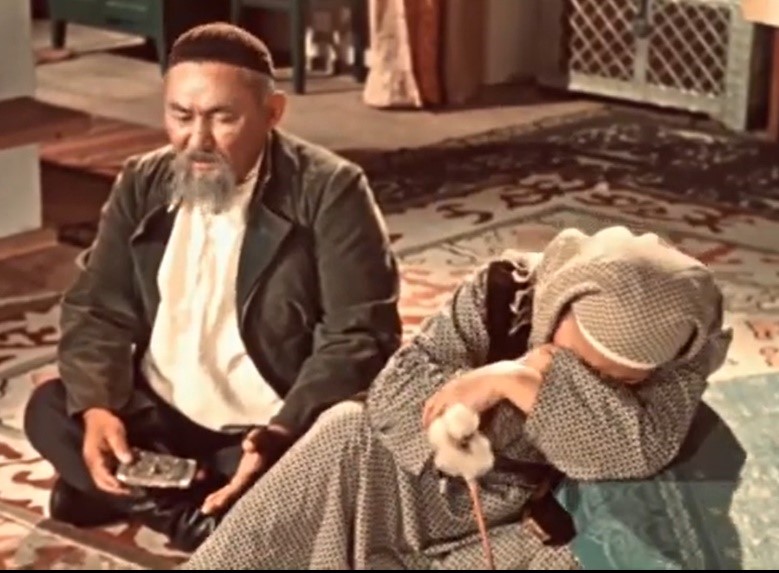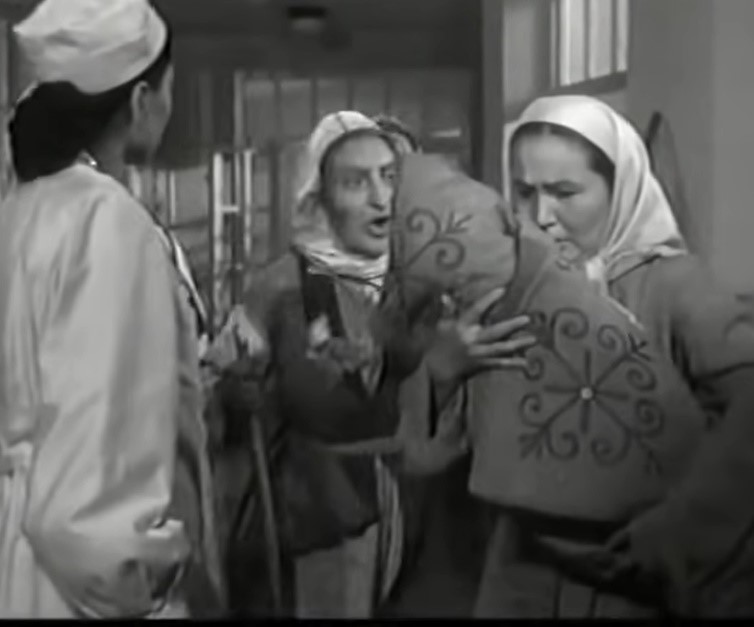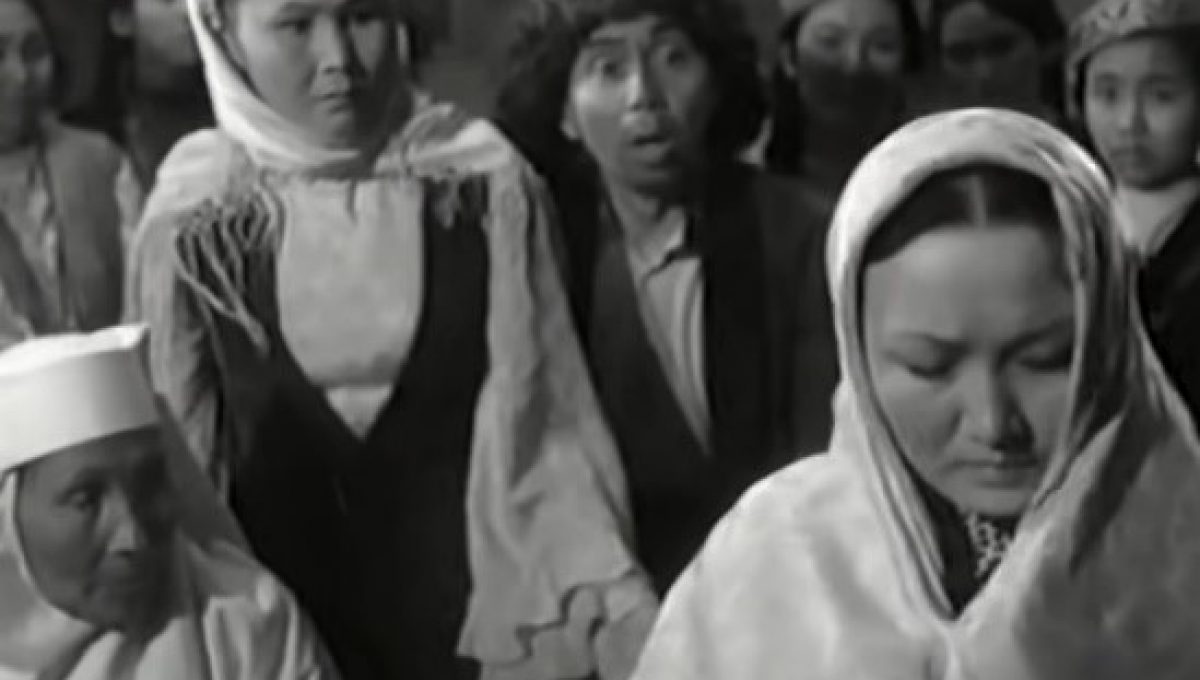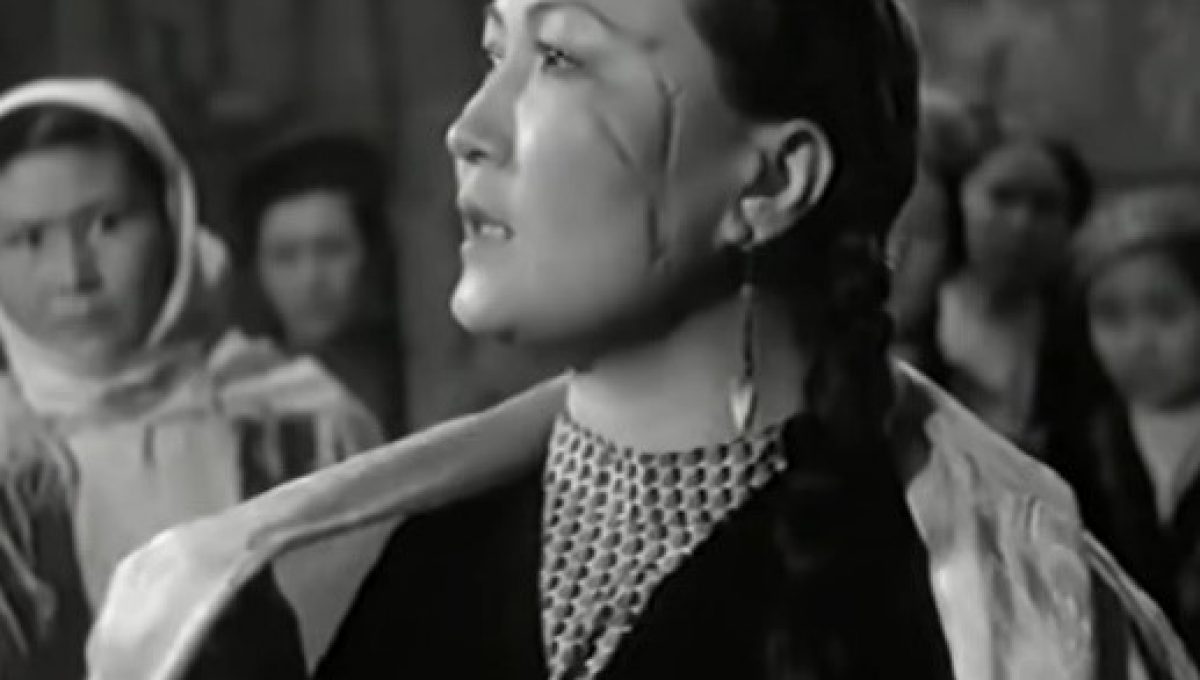Kazakh women in Soviet cinema were deprived of cultural identity, often in favor of the ideological demands of the Soviet administration, for example, in order to emancipate women and attract them to the workforce. There is a reverse trend in modern Kazakh cinema, where women are deprived of their rights and accused of disrespect for traditional norms, according to Nargiz Kapasheva, a graduate of the School of Analytics CABAR.asia, researcher and expert analyst.

For example, the heroine of the film “Daughter of the Steppes”, forcibly married in childhood, later falls under the guardianship of a Russian intellectual and becomes a scientific researcher – “a full-fledged builder of socialism” (1954). It is especially emphasized that socialism was built in the conditions of the “bare steppe”, that is, in fact, from scratch. It was important for Soviet propaganda to emphasize the coming “civilization” to the country, factories, and the personal lives of citizens, including women.
Similarly, in the film “We Live Here,” the development in the conditions of the same “bare steppe” takes place after the arrival of Slavic workers for the “Tselinna” campaign sent by Moscow (1957). One of the heroines of this film, whom her husband abandoned, highlights that traditions are not a guarantee of high morals. Thus, her younger sister Khalida is given out as a virgin of European nationality, which allows visitors to build reforms and move without the indignation of local residents.

Since the late 1920s, the Soviet Union has embarked on a new genre of art – “socialist realism”. The following elements belong to this genre: the ideological representation of political reforms, the absence of antagonists and opposing forces in the works, and the straightforward and extremely closed narrative of the plot. After Stalin’s death, the framework for making films was weakened, and directors everywhere understood that changes were coming in creativity. Lidia Okuderova, an academician in the field of Soviet cinema, informs that references and allegories in cinema acquire an “open character”, where the viewer is given the opportunity to interpret the author’s symbolism himself. In addition, the frames have become much more dynamic[1]. In the mid-1950s, there was also an emergence of color in cinema – technological innovations on the market.
Moreover, the frontier (periphery) of the country receives more attention, that is, everything that is considered not the “center” of the Soviet imperial machine [2]. These include the former colonies of the tsarist empire. What makes the period of the 1950s the most meaningful for research in the field of Bolshevik cinema, the filmmakers of the republics were given privileges to shoot national films[3]. All this was done in accordance with the policy of the center, which gave clear instructions for the promotion of specific ideas.
In regard to national politics, since 1932, Stalin has regarded European nationalities as the “elder brothers” of the Union republics. This creates a hierarchy of nationalities [4]. Eastern women, as the most uneducated and “ignorant” stratum of the population, influenced by Islam, patriarchal and traditional foundations, most of all classes and groups need emancipation and “retraining”[5].
Stalin’s death, in this case, meant the long-awaited voicing of acute topics and transformations in the social and cultural sphere of people. Thus, at the moment, there is more relevance in the revision and analysis of national films of the 1950s, including those affecting the status of women, as there are more opportunities to voice topics that are crucial for society.
Speaking of existing research, postcolonialism has not been studied much in the CIS countries yet. When it comes to discrimination against various groups, the modern public has the idea that racism does not exist in our society. Postcolonialism makes it possible to draw attention to the discrimination of ethnic groups outside of Western ideas about race.
There is also a reverse discourse within this concept. Some groups of the population, on the contrary, believe that colonization by the Soviet Union was initially beneficial because it is one of the ways to civilization, new technologies, the growth of urbanization, etc. At the same time, the concept of “modernity” and “civility” are extremely subjective and could have been imposed by the Soviet administration to create a sense of backwardness in the peripheral republics, a hierarchy based on this “development” and centralization of power in the hands of a more dominant Slavic settlement.
The postcolonial theory by Edward Said, an American academic of Arab origin, asserts that the East or Orient has several definitions and functions[6]. Thus, the Soviet film propaganda partly repeated Western trends, where, firstly, the East is “the Other”, and the West (Moscow in our case) with a European (Slavic) population dominates, setting the contrast between “developed” and “uncivilized”.
For example, such techniques can be noted in the typical reconceptualization of traditions and culture of nomadic peoples, changing historical events to create stereotypes about backwardness or illiteracy, caricaturing certain types of population or social classes, and other techniques that Soviet cinema often resorted to.
Secondly, Orient is a system of knowledge and theory production. In the two films, the national culture of the Kazakhs is used to introduce and promote the “friendship of peoples”, the emancipation of steppe women, and coverage of political reforms such as the development of virgin lands. In this case, Said’s theory can be practical for interpreting cases of inequality and domination of one culture over another, images of “backwardness” and the life of the frontier (periphery).
In order to track these phenomena in detail, the analysis of dialogues between the characters, the setting of objects in the frame, the color scheme, the sequence of the plot (the content and order of events in the films), the use of various symbols to present metaphors to the viewer will be used.
Shaken Aimanov, the founder of Soviet cinema in Kazakhstan, tries to reveal different nationalities on relatively equal levels to represent the ideology of “friendship of peoples”. This is exactly why the indigenous Kazakh population plays advanced employees. For example, Dina, a resident of the village in “We Live Here” holds the post of a chief agronomist. Representatives of the Virgin Lands secretariat are mainly Kazakhs. However, it is with the arrival of other specialists that real development takes place. The “deaf Kazakh steppe,” which previously “had not seen people, did not know the plow,” becomes a symbol of abundance, transformed from an aul (village) into a progressive urban-type settlement. Note that the newcomers are mainly of Slavic origin.
A similar moment is noticeable in the film “Daughter of the Steppes.” The main characters, Nurzhamal and Murat, become authoritative and influential thanks to the influence of Lyubov Petrovna, a visiting doctor of European nationality from Moscow. The main character notes the following: “A kind Russian woman saved me.” Lyubov Petrovna, a doctor, helps the girl in defending her diploma in Moscow and sends her to study in Almaty. Ak Tas, the native village, is also being transformed from a bunch of yurts in the steppe into a full-fledged and equipped urban-type settlement, thanks to European influence.
According to Soviet ideology, the traditional character of Kazakhs, bordering on backwardness and patriarchy, can harm women. These ideas are noticeable in the film ““Daughter of the Steppes,” where the story of Nurzhamal should be indicative of many Eastern women. It begins with the forced sale of the girl to a poor shepherd Malgabar for a kalym. In the course of this conflict, the following phrases are used: “– Give her to me, I am its owner. – No, she belongs to me,” emphasizing the attitude towards a woman as an object. This problem is played out further in the village when the young girl gets to the meeting of the so-called “red yurts”. The meeting is headed by Lyubov Petrovna and other European women, urging Kazakh women to share their experiences about being exploited.
Red yurts, as institutions of women’s emancipation, are historically reliable. As noted by academician Tatiana Shchurko, who wrote about gender issues in the Soviet Union, one of the most frequent topics addressed in these institutions included education about the importance of the proletariat, sanitary and hygienic standards, equal rights, and victory over backward traditions[7]. They also include dressing a woman in European clothes and removing the burqa or other types of coverage. One of these episodic characters in a red yurt takes off her veil and reveals the scar received when trying to evade polygamy from the eldest son of Aktambay. When the heroine decides to tell her story, her voice and behavior become more confident. At the same time, it turns out that European clothes are hidden under the girl’s covering.
“Daughter of the steppes”. Transformation of the image of a girl at a meeting of “red yurts”.
In addition, Aimanov reveals the idea that the presence of traditions in society does not always mean decency or high morals. Khalida, in the film “We Live Here,” the daughter of a conservative Kazakh family, finds happiness with a Slavic migrant and brigadier Sergei. Parents perceive this news negatively, fearing shame because of the alien culture of the groom. The background here is the marriage of Dina, the chief agronomist of the Virgin village. Despite the “native” nationality of Kuanysh, her former husband, he leaves his wife and daughter at the most difficult moment and “puts sticks in the wheels” when sowing and implementing agrarian reform. The author thus hints that tradition and nationality are far from the main factors in a happy marriage. Against this background, Sergey becomes a decent man and a worthy groom for the local Kazakh girl. This story can be indicative of the settlers, creating the impression of a warm welcome from the locals and the opportunity to integrate their traditions and identity into society seamlessly.
Shots from the movie “We Live Here”. Newlyweds during the wedding celebrations. Sergey is on the left, and Khalida is on the right.
At the same time, representation and traditions can be useful if they fit into the Soviet framework of culture and civility. Nurzhamal, the main heroine of the film “Daughter of the Steppes,” uses a healing remedy of folk healers “Gulraushan” and proves the validity of her beliefs in a laboratory way available in Almaty. Despite the stereotypes about the backwardness of this kind of knowledge, the heroine was still able to prove her value as a competent specialist and showed the scientific society the miraculous influence of traditional methods of treatment.

Although films were dominated by political propaganda, forcing colonial stereotypes, they could still show some positive changes in society. Likewise, emancipation had extremely high rates, giving women hope for the prospect of an independent existence and liberation from patriarchy.
“In 1940, women made up about a third of the wage labor force in all sectors of Soviet Kazakhstan and Uzbekistan; and by the 1970s and 1980s, this figure had grown to almost 50 percent, while female literacy in both republics was almost universal.”[8]
In the end, Nurzhamal speaks with the following words: “How much did I have to go through, an ordinary shepherd’s daughter, to get the simple right to be called a human? I am glad that the path we have passed is far behind you.”
Choosing between family and work, she realized her social duty and became a cult figure in society. A similar argument is noticeable in the story of Khalida, where the young woman chose personal happiness, sacrificing traditions. Such examples could inspire not only women of the 1950s but also of the present.
New cinema – new stereotypes
Modern Kazakhstan, having undergone a series of colonial practices from imperial to socialist times, faces identical problems. Women are increasingly becoming independent and urbanized citizens. At the same time, modern Kazakh cinema ridicules such emancipation without highlighting its problems. For example, frequent divorces and a decrease in the role of men in the family, the need for financial independence, providing for children, and stereotypes associated with divorce.
For example, a frequent directorial technique is to describe young and attractive women from Almaty or the capital as vain and financially obsessed. This is noticeable in almost all films aimed at commercial success among the masses. For example, “Kudalar”, “All because of men”, “Kazakh Business”, “Kelinka Sabina” and so on. Seeing that women’s ambitions and roles are changing in society, local directors struggle with such changes by exaggerating and strengthening traditional (i.e. patriarchal) gender roles.
Despite such a one-sided view of the role of women in society and their problems, the filmmakers often try to forcibly introduce the principles of patriarchal traditionalism into the heroines. The films directed by Nurtas Adambayev are vivid examples of regressive views on the role of women.
According to the portal “CABAR.asia,” cinema is mainly a tool for the representation of certain attitudes and behaviors. “Kelinka Sabina,” a story describing the abduction of a city woman to an aul, tries to show the positive side of traditional and patriarchal foundations in a comedic form. As Adambayev noted in an interview: “‘Kelinka Sabina’” is actually a movie about Islam. Because Islam is very protective of family relations. Islam regulates relations within the family, that the wife should have her duties and rights, the husband should have his own.”
At the same time, the film normalizes the exploitation and marginal position of “kelin” in society, “alyp kashu” (the tradition of stealing brides).

As in the film, the main character, Sabina, appears helpless before the oppression of relatives and foundations. In the foreground, a woman begs for mercy, and in the far one, her running silhouette is visible, being chased by villagers. At the end of the film, she decides to join her “husband’s” family and embrace a rural lifestyle, despite all the violence she has experienced.
Nurlan Adambayev himself criticized any films and other works in the film production that touch on the topic of LGBT, although he himself directly participated in the performance of female roles, for example, dressing up in Sabina (crossdressing). The topic of LGBT and feminism still remains extremely acute within the post-Soviet space, including Kazakhstan. The most resonant is the speech of Majilisman and former athlete Ardak Nazarov, in which the politician called for the introduction of legislative norms prohibiting LGBT propaganda.
The reason for criticism was the parade from “Feminita”, held in Astana on April 8, at which children held LGBT flags in their hands. Meanwhile, Nazarov’s speech on April 12 coincides with a larger political event in Kazakhstan – the speech of the workers of the city of Zhanaozen that led to the January events of 2022.
In this case, such agitation can be considered either as political populism with a desire to attract more conservative groups of the population in the country due to the low support of the government or as an attempt to shift public attention from anti-government protests that occurred a day earlier.
Kazakh women, both in the present and in the past, are forced to conform to the traditional foundations that society and the political regime dictate to them. At the same time, few are ready to show the reality of the daily life of the heroines. As the director of the film “Zere”, Dauren Kamshibaev, expressed: “It seems to me that there are not enough heroines in our cinema and most often in the scenes a woman is an interior item.” As long as producers are ready to exploit female images, they will remain silent for the public and society as extras, no matter what time it is – colonial or modern.
As a recommendation, it is necessary to develop conditions for the direct involvement of women in the film industry, for example, by allocating quotas for female directors. Thus, there will probably be more opportunities to highlight gender issues.
In addition, it is necessary to interrupt the trend of producing commercial films that are based on the propaganda of morally and physically degrading stereotypes under the pretext of “traditions” and “correct family roles”. This cannot be understood otherwise than as the humiliation of women and the propaganda of pseudo-conservative traditional foundations. In addition, it is important to produce box-office films highlighting significant problems in society, in this case, gender, where viewers could learn and prevent gender-based violence and discrimination and not encourage these negative phenomena under the guise of a “return to normality”.
[1] Oukaderova, Lida. The Cinema of the Soviet Thaw: Space, Materiality, Movement. Bloomington, Indiana: Indiana University Press, 2017, 185.
[2] Etkind, Aleksandr. Internal Colonization: Russia’s Imperial Experience. Cambridge, England: Polity, 2011.
[3] Абикеева, Гульнара, and Алим Сабитов. “Кино Советского Казахстана: Как Работали Советские Идеологемы.” Acta Slavica Iaponica 41 (January 7, 2022): 60.
Etkind, Aleksandr. Internal Colonization: Russia’s Imperial Experience. Cambridge, England: Polity, 2011
[4] Martin, Terry. The Affirmative Action Empire: Nations and Nationalism in the Soviet Union, 1923-1939. Ithaca, New York: Cornell University Press, 2001, 303-04.
[5] Ubiria, Grigol. Soviet Nation-Building in Central Asia: The Making of the Kazakh and Uzbek Nations. London, England: Routledge, 2018, 188.
[6] Ahmad, Aijaz. In Theory: Classes, Nations, Literatures. London, England: Verso, 2008.
Etkind, Aleksandr. Internal Colonization: Russia’s Imperial Experience. Cambridge, England: Polity, 2011, 179.
[7] Щурко, Татьяна. “«Женщина Востока»: Советский Гендерный Порядок в Центральной Азии Между Колонизацией и Эмансипацией.” Essay. In Понятие о Советском в Центральной Азии, 178–209. Бишкек, Киргизия: Штаб-Press, 2016, 204.
[8] Ubiria, Grigol. Soviet Nation-Building in Central Asia: The Making of the Kazakh and Uzbek Nations. London, England: Routledge, 2018, 196.





